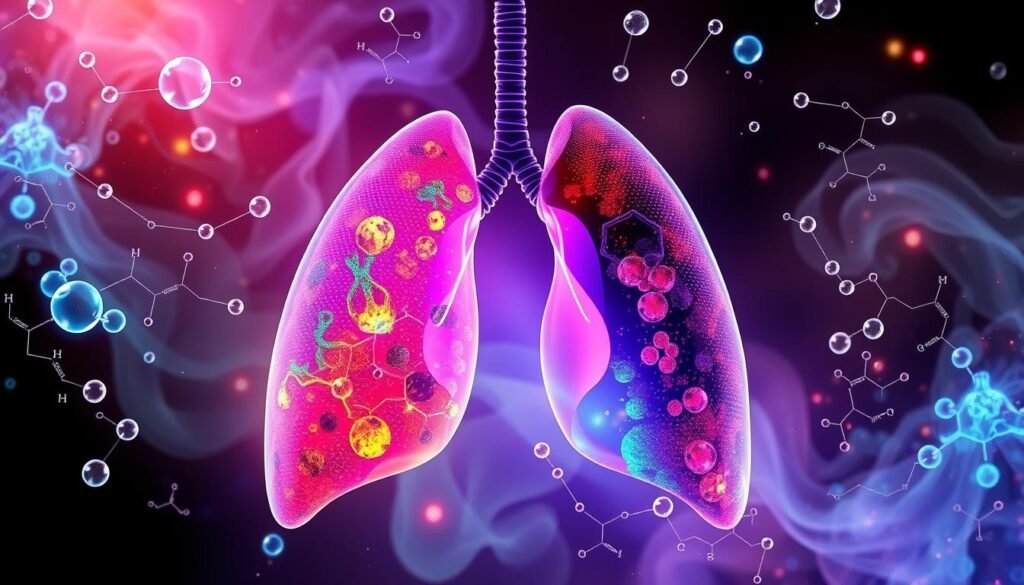Do you know that over 80% of lung cancer cases are due to non-small cell lung cancer (NSCLC)? This fact stresses the importance and complexity of treating lung cancer today. When looking at treatments, the role of chemotherapy for advanced lung cancer is key. Understanding chemotherapy’s impact is vital for patients and healthcare professionals, offering more than just survival numbers.
Chemotherapy is often used with other treatments, like immunotherapy and targeted therapy. It’s central in the fight against advanced lung cancer. For example, the phase 3 KEYNOTE-189 trial showed notable results. Patients who received pembrolizumab and chemotherapy had a one-year survival rate of 69%. This was much higher than the 49% for those with chemotherapy only. It shows the importance of not just chemotherapy but its combination with new treatments.
Looking closely at chemotherapy’s role in treating lung cancer helps a lot. It enables patients to make wise decisions. Considering everything from survival rates to possible side effects, chemotherapy is key in treating advanced lung cancer. This article will explain how chemotherapy works and its place in current lung cancer treatment. For more on chemotherapy, visit this resource.
Key Takeaways
- Chemotherapy plays a critical role in lung cancer treatment, particularly for advanced cases.
- The combination of chemotherapy with immunotherapy can substantially improve survival rates.
- Over 80% of lung cancer cases are non-small cell lung cancer, a key focus of chemotherapy research.
- Understanding chemotherapy’s effectiveness is pivotal in guiding patient treatment choices.
- Recent trials indicate that innovative combination therapies may enhance treatment outcomes.
Introduction to Lung Cancer
Lung cancer is the top cause of cancer-related mortality worldwide. It comes in two key types: non-small cell lung cancer (NSCLC) and small cell lung cancer (SCLC). Statistics reveal its high occurrence, highlighting the need for better treatments. Thanks to new therapies, patient survival rates have improved. However, the disease’s aggressive nature makes early diagnosis tough, affecting treatment success.
Managing lung cancer often involves multiple therapies. These can include surgery, radiation, immunotherapy, and chemotherapy. Chemotherapy is essential, used both as a standalone and supportive treatment. For example, it can shrink tumors before surgery to make the procedure more effective.
Many factors impact survival rates in lung cancer patients. These factors range from the type of treatment and cancer stage to the patient’s overall health. Ongoing research is looking at how tumor genetics and treatment plans affect outcomes. This research aims to find ways to prolong life and improve the quality of life for those with lung cancer. For further information, read about the effectiveness of chemotherapy.
Understanding Advanced Lung Cancer
Advanced lung cancer is serious. It means the cancer has spread from where it started. This is often called metastatic disease. It’s when the cancer moves to new areas like the liver, bones, and brain. Understanding the cancer’s spread is key to treating it.
Different things impact how advanced lung cancer grows. This includes genetic changes in the cancer itself. The patient’s overall health also matters a lot. It influences which treatments might work best.
Knowing where the cancer is likely to spread is important. Each patient needs a treatment plan made just for them. Healthcare teams work hard to find the best ways to help patients. This is how they aim to improve lives.
Purpose of Chemotherapy in Lung Cancer Treatment
Chemotherapy is key in treating lung cancer, especially for non-small cell lung cancer (NSCLC). It’s used as neoadjuvant therapy to shrink tumors before surgery. This makes removing the tumor easier and ups the success rate. Also, chemotherapy acts as adjuvant therapy after surgery. It targets any lingering cancer cells to help stop the cancer from coming back.
For those with stage IV lung cancer, chemotherapy is often the main treatment. It’s crucial for palliative therapy, which aims to ease symptoms and improve life quality during metastatic cancer. The treatment may involve drugs like Cisplatin, Carboplatin, and Paclitaxel. These are chosen based on what’s best for the patient.
Neoadjuvant and adjuvant chemotherapy usually last three to four months. The treatment plan depends on the cancer stage and patient specifics. Doctors might pick a combo of two drugs or just one, depending on health and treatment tolerance. Monitoring side effects and how well the treatment works is vital. For more info, check out Cancer.gov.
Effectiveness of Chemotherapy for Advanced Lung Cancer
Chemotherapy is key in fighting advanced lung cancer. It significantly impacts how long patients live. By looking at survival rates, we see how different chemotherapy plans help tackle this difficult illness. Checking the chemotherapy effectiveness tells us how well these treatments do compared to others.
Survival Rates Associated with Chemotherapy
Studies show that chemotherapy can extend the life of people with advanced lung cancer. Older patients, for example, live about 33 days longer with this treatment. The chance of surviving a year goes up by 9%, thanks to chemotherapy. This shows a strong connection between getting chemotherapy and living longer.
Comparison with Other Treatment Modalities
Looking at chemotherapy against other treatments, like immunotherapy and targeted therapies, shows some clear differences. For certain non-small cell lung cancer (NSCLC) patients, chemotherapy is very useful. When used with other treatments, they work even better, leading to longer survival rates and better treatment outcomes. This mix of treatments underlines the importance of customizing care for lung cancer patients.

Common Chemotherapy Drugs Used
Chemotherapy is vital in lung cancer treatment. It uses special drugs to fight the disease. These drugs, like cisplatin and carboplatin, are key in battling advanced lung cancer. Knowing about these drugs helps understand their power in treatment.
Cisplatin and Carboplatin
Cisplatin and carboplatin are top choices for lung cancer therapy. They are platinum-based and form the core of many treatment plans. They’re mainly used for two types of lung cancer: non-small-cell (NSCLC) and small-cell lung cancer (SCLC).
For SCLC, they might be used with etoposide to combat this aggressive cancer. In NSCLC cases, they are paired with drugs like docetaxel and gemcitabine. This mixture boosts the effectiveness of the treatment.
New Generation Agents
Recent drugs aim to improve patient outcomes alongside traditional treatments. Pemetrexed, docetaxel, and gemcitabine are key in today’s lung cancer fight. They tackle the tumor from different angles, offering more options for patients.
Used with cisplatin and carboplatin, their impact is significant. They’ve become essential in advanced lung cancer care. They are known for better responses and being easier to tolerate for some patients.
| Chemotherapy Drug | Type | Common Use |
|---|---|---|
| Cisplatin | Platinum-based | NSCLC, SCLC |
| Carboplatin | Platinum-based | NSCLC, SCLC |
| Pemetrexed | New generation | NSCLC |
| Docetaxel | New generation | NSCLC |
| Gemcitabine | New generation | NSCLC |
| Vinorelbine | Conventional | NSCLC |
Chemotherapy Administration and Treatment Cycles
Chemotherapy for advanced lung cancer uses treatment protocols for the best results with fewer side effects. It involves chemotherapy cycles to give patients recovery time. Doctors often start with 4 to 6 cycles, sometimes adding therapies like immunotherapy.
Standard Protocols for Treatment
For small-cell lung cancer (SCLC), drug combos like Cisplatin and Etoposide or Carboplatin and Etoposide are used. Chemotherapy is given through veins, either quickly or over time. The drug choice can change based on how the cancer responds or if it comes back.
Maintenance Therapy Considerations
After the first chemotherapy cycles, maintenance therapy might start with milder medicines. This helps extend treatment benefits and manage side effects. It’s important to watch closely and tweak the treatment to keep a good balance between effectiveness and life quality.

Chemotherapy Side Effects
Chemotherapy is key in treating lung cancer, but knowing its side effects is crucial. Being aware helps patients deal with upcoming challenges. This makes the treatment journey smoother.
Common Side Effects Experienced
Lung cancer patients on chemotherapy may face several side effects, such as:
- Nausea and vomiting
- Fatigue
- Hair loss
- Mouth sores
- Diarrhea
- Peripheral nerve damage (peripheral neuropathy)
- Low blood cell counts, leading to increased infection risk
The experience varies from person to person. Some deal with many side effects, while others have fewer issues. The type of chemo drugs and overall health matter a lot.
Management of Side Effects
Handling side effects well is essential. You can do things like:
- Utilizing anti-nausea medications
- Maintaining diligent oral hygiene practices
- Incorporating dietary modifications
- Engaging in cognitive activities to combat chemobrain
Talking with healthcare teams lets patients manage side effects better. With the right support and information, patients improve their treatment journey. Keeping in touch with doctors is vital because cancer can reappear. For extra info on chemo for lung cancer, click here.
Integration with Other Treatment Approaches
Advanced lung cancer treatment combines multiple methods to improve patient outcomes. This includes chemotherapy, targeted therapy, and immunotherapy tailored to each person’s needs. These treatments are especially important after the cancer progresses despite initial efforts.
Combination with Targeted Therapy and Immunotherapy
Targeted therapy and immunotherapy play key roles in advanced lung cancer care. They work well with chemotherapy, leading to better outcomes. For example, combining targeted therapy with chemotherapy resulted in an 82.9% response rate. Meanwhile, pairing chemotherapy with immunotherapy achieved a 80.8% response rate. These results show how chemotherapy is essential in a plan designed to enhance survival rates.
Role of Palliative Care in Advanced Lung Cancer
Palliative care is crucial for managing symptoms and improving life quality in advanced lung cancer. It addresses the complex needs of these patients. Teams offer support that works well with other therapies, easing physical, emotional, and psychological burdens. Such comprehensive care is key to patient satisfaction and well-being.

More research is needed to fully understand these treatment methods. Gathering more data will clarify how chemotherapy complements targeted therapy and immunotherapy. This includes looking at how these treatments affect survival and quality of life. Those interested in the latest lung cancer treatments can find more info through this link.
Clinical Trials and Emerging Research
Clinical trials are key to moving lung cancer research forward. They test new treatments to find better options. By studying different drugs together, these trials aim to improve patient outcomes.
New Findings on Effectiveness
Targeted therapies are making a big difference for certain lung cancer patients. Doctors use advanced tests to find specific mutations in cancer cells. This helps choose treatments that are more likely to work well.
Many trials show that these new treatments can help patients live longer. They are testing new drugs that are showing good results.
Future Directions in Therapy
Looking ahead, lung cancer treatments are becoming more advanced. Researchers are trying new ways to overcome drug resistance. Combining unique drugs and immune therapies looks promising.
Conclusion
Lung cancer is a tough battle, especially in advanced stages. Chemotherapy is key in this fight. It’s proven to help patients live longer compared to just getting supportive care.
Unfortunately, the survival rate for those diagnosed at distant stages is still very low, at only 5%. This fact shows how badly we need effective treatments.
Choosing the right chemo is also important. Studies show platinum-based chemo works better than others. It offers the highest chance of shrinking the cancer.
Treatments tailored to the tumor’s specific traits could improve survival rates. Plus, doctors and patients need to talk more to make the best decisions. Better information leads to better outcomes, as highlighted in a recent study.
Chemotherapy can extend lives and improve the quality of them too. But for this to happen, ongoing research and new treatments are vital.
Working together and staying informed will shape lung cancer care’s future. It will let patients choose wisely regarding their treatment. The focus on new treatments and caring support is key in beating lung cancer.